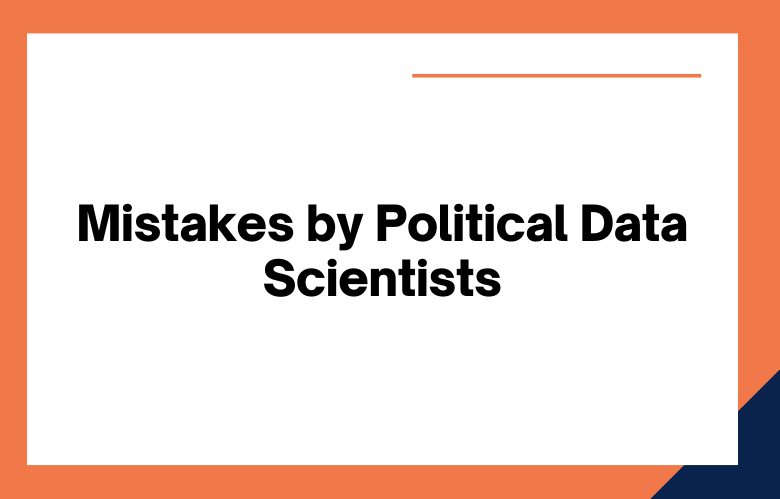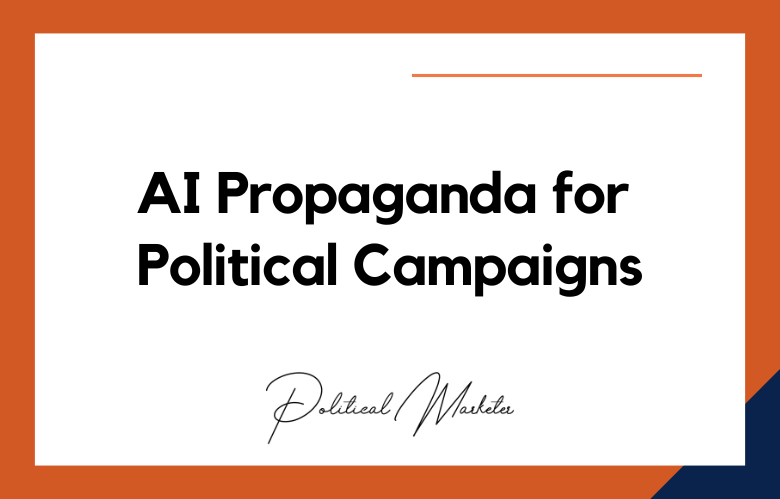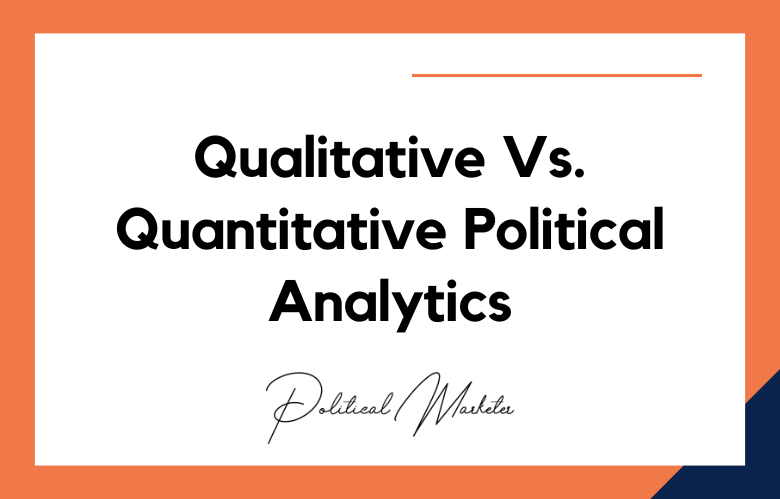As a political data scientist, you are constantly working to improve the accuracy and reliability of your models. But even the best data scientists can make mistakes. We’ll examine some of the political data scientists’ most common mistakes and how to avoid them.
Political data scientists make mistakes too! In this blog post, I will highlight the most common ones so you can avoid them. It is pivotal information for anyone working with political data, as small mistakes can impact your analysis.
Political data science is relatively new, and many mistakes arise. We’ll list the most common mistakes political data scientists make and provide tips on avoiding them.
The Most Common Mistakes Made by Political Data Scientists
They do not understand the data. It is by far the most common mistake I have seen. Too often, people don’t take the time to understand what the data tells them. As a result, they make incorrect assumptions and conclusions.
You are not accounting for errors; another frequent mistake is not accounting for errors in the data. It can lead to inaccurate results and conclusions.
They are ignoring outliers. Outliers can often provide crucial information that can change the outcome of an analysis. However, many people ignore them, thinking they’re not necessary. It can lead to missing out on critical insights.
One of the most common mistakes political data scientists make is failing to consider the weight of prior beliefs.
Bayesian analysis, which considers priors, can be incredibly useful for political data scientists.
Skewing data to fit a pre-determined narrative
You do not understand the nuance of complex issues.
Making assumptions about what voters want without consulting them first
Pitching ideas that are too far outside the mainstream
Clinging to comfortable orthodoxies instead of challenging them.
Another common mistake is neglecting to track and monitor changes in data over time. It can result in missing significant trends and patterns.
Some data scientists mistake relying too heavily on models and algorithms. It can lead to oversimplification and a lack of understanding of the complexities of the real world.
Failing to analyze data properly
Drawing incorrect conclusions
Relying too heavily on opinion polls
I am not being able to adjust to changing circumstances.
Ignoring important factors
One mistake is thinking they can install a few packages and does with them. There is a lot more to becoming a competent data scientist than that!
Another mistake is underestimating the importance of data cleaning and preparation. The algorithms are essential, but you will not get far if your data is messy.
Data science is crunching numbers – it’s about telling a story that will resonate with your audience.
The most common mistake political data scientists make is failing to consider the impact of the data they collect on society. By collecting and analyzing data without considering its potential consequences, they risk exacerbating existing social problems or creating new ones.
If data scientists want to avoid making mistakes that could have harmful real-world repercussions, they need to be aware of the potential impact of their work and proceed with caution.
One is incorrectly assuming that all data is created equal. Another is not correctly understanding the strengths and weaknesses of different data types.
Failing to clean and filter data properly can introduce bias and inaccuracies into your models and analysis.
Not segmenting your data can lead to missed opportunities and oversimplification of complex issues.
Reliance on a single tool or method can be dangerous, especially in an ever-changing political field.
Data scientists must be vigilant in identifying and avoiding potential sources of error.
One is failing to consider the survey design when analyzing poll data. Another is not incorporating fieldwork knowledge when making decisions about electoral strategies. And finally, relying too heavily on simulation models can lead to flawed conclusions.
Data scientists must get it right with much at stake in today’s political climate. Awareness of these common mistakes can help ensure their work is as accurate and effective as possible.
Political data scientists make failing to contextualize the data correctly.
It can lead to inaccurate conclusions and, ultimately, Failure.
Scientists often overlook the instability of “live” data.
New data is constantly coming in, and old data may no longer be accurate, so it’s essential to monitor and adjust as needed continually.
Another easy mistake to make is relying too heavily on regression analysis.
Regression models can be helpful, but they should use as just one tool in your toolbox.
I do not understand the data.
Sometimes data scientists can get so caught up in number crunching and Excel that they forget the essential part of their job is understanding what the data is saying. Often, overly complicated models create when a more straightforward approach would suffice.
Political data is notoriously messy, and it takes a skilled data scientist to sift through all the noise to find the signal.
I do not have experiences outside of academia.
A lot of times, political data scientists will get their experience exclusively from working in academic settings. But being successful in the field of politics requires a lot more.
One of the political data scientists’ most common mistakes is failing to consider that people often vote based on emotion, not logic.
Another mistake is failing to consider all the factors influencing an election.
Another standard error assumes that all voters will decide based on the same information.
Some errors include failing to account for critical variables, not properly analyzing data, and making assumptions about the electorate.
Failing to account for critical variables can lead to inaccurate predictions and poor decision-making.
Not correctly analyzing data can also lead to faulty conclusions and wasted resources.
Making assumptions about the electorate can result in missing critical information and alienating potential voters.
Attempting to model human behavior
We are not computers or voters. Trying to predict turnout based on past voting history is a mug’s game. Just because someone voted in the last three presidential elections does not mean they will do so again. Statistics take you so far in understanding human behavior.
Failing to understand how the media works
The media does not operate in a vacuum. They influence by political actors and events just as much as anyone else. They understand how the media works are crucial to understanding how politics works.
One mistake political data scientists often make is assuming that all data is accurate. However, data can be inaccurate for various reasons, including errors in measuring or recording.
Another mistake is understanding how different kinds of data are used. For example, a data scientist might not realize that demographic data predict voting behavior.
Political data scientists sometimes think their job is to crunch numbers and produce statistical models. While these skills are essential, data scientists also need to be able to communicate their findings to non-technical audiences.
There’s no need to be a Data scientist to get into politics. However, if you want to be one, there are a few things you should avoid doing. Here are some errors made by political data scientists:
They are not collaborating with colleagues outside of their field, not engaging in active listening, and failing to be aware of their own biases.
They assume that all data is created equal. Data from a reliable source doesn’t mean it’s automatically usable. Sometimes information needs to be cleaned or processed before it uses effectively.
It is not considering the effect of outside variables. When analyzing data, it’s essential to take into account factors that could be influencing the results. For example, if you’re looking at election results, consider things like voter turnout and previous election results.
- Assuming that all data is clean and ready to be used
- Not accounting for selection bias in data sets
- Concluding too small of a data set
- Focusing on the wrong metrics
- Over-interpreting results
- Underestimating the impact of political context on data analysis
- Assuming linear relationships when there may be nonlinear relationships
- Misunderstanding how uncertainty affects political data
- . Concluding too little data
- Incorrectly applying statistical methods
- Oversimplifying data
- The data do not support drawing conclusions
- Assuming causality when there is only a correlation
- Failing to account for uncertainty
- Making decisions based on personal biases
- Focusing on the wrong data
- Underestimating the impact of human bias
- Over-complicating things
- Not checking their work
- Assuming they know everything
- Ignoring the political context
- Letting personal preferences get in the way
- Getting caught up in confirmation bias
- Failing to account for sampling bias
- Underestimating the impact of incumbency
- Assuming that all voters are rational actors
- Overestimating the power of information campaigns
- Misunderstanding how partisanship shapes voting behavior
- Minimizing the impact of social media on political behavior
- Ignoring the role of emotions in politics
- Focusing too much on presidential elections
- Failing to account for the margin of error in polling data
- Underestimating the impact of social media on voter behavior
- Misinterpreting data because of personal biases
- Concluding too small a sample size
- Assuming that all voters are rational actors
- Over-reliance on polls as predictors of election outcomes
- Not understanding the role of emotions in voting behavior
- Not checking for bias in the data set
- Misinterpreting correlations as causation
- complex Oversimplifying models
- Failing to account for uncertainty
- Underestimating the importance of human intuition and judgment
- Forgetting that data science is a team sport
- Minimizing the impact of race and ethnicity on voting behavior
- Assuming that people vote the way they say they will in polls
- Failing to account for undecided voters in analyses
- Overestimating the effect of money on elections
- Misunderstanding how partisanship affects voter behavior
- Ignoring social media data in the analysis
- Forgetting about local races and their impact on national politics
- Not paying enough attention to demographics
- Assuming that data is the only factor that matters in a political race
- Underestimating the impact of human behavior and emotion on politics
- Not taking into account how quickly things can change in the world of politics
- Focusing too much on statistical models and not enough on real-world events
- Relying too heavily on data from past elections instead of collecting new data
- Ignoring the importance of communication and visualization when working with data
- Forgetting to consider ethics when gathering, analyzing, and using political data
Conclusion
As political data scientists, we provide insights and analysis on everything from the upcoming election to how social media affects voter turnout. And while we love a good challenge, we also want to ensure our clients get the most accurate information possible. We have outlined the most common errors made by political data scientists.
Contact us today if you’re looking for help with your next project or want more information on how to get started in political data science. We’d be happy to discuss your needs and see how we can help!
One way to get in touch is by filling out our online form on this site or give us a call at
+91 9848321284. Let’s work together today!
The Most Common Mistakes Made by Political Data Scientists: FAQs
What Is A Political Data Scientist?
A political data scientist analyzes voter data, polling trends, and behavioral insights to inform campaign strategies and decision-making.
Why Do Political Data Scientists Often Misinterpret Voter Sentiment?
They may rely too heavily on quantitative data while ignoring qualitative signals such as cultural cues, tone, or regional context.
What Is Data Overfitting In Political Campaigns?
Overfitting happens when a model becomes too tailored to past data, losing generalizability for new voters or future elections.
How Can Ignoring Local Context Lead To Faulty Predictions?
Models that don’t account for caste, language, religion, or regional history can produce misleading voter behavior forecasts.
Why Is Clean Data Crucial In Political Analytics?
Dirty or inconsistent data skews models, affects targeting accuracy, and compromises strategic decisions.
What Is The Risk Of Relying Solely On Social Media Data?
Social media reflects only a vocal minority and may exclude rural or offline voter segments, leading to sampling bias.
How Can Confirmation Bias Affect Political Data Work?
Analysts may unconsciously seek patterns that validate campaign assumptions, overlooking contradictory trends.
Why Is Real-Time Data Calibration Important During Elections?
Campaign conditions change rapidly; outdated models can fail to capture swing voter shifts, crisis response, or opponent impact.
What Happens When Survey Sampling Is Not Representative?
Non-representative samples distort reality, creating false impressions about popularity, turnout, or issues of concern.
Why Must Data Scientists Collaborate With Ground-Level Workers?
Field-level insights validate models and uncover nuances that raw data may not capture, especially in diverse electorates.
How Can Mislabeling Voter Segments Be Harmful?
Incorrect classifications can misdirect resources and messaging, alienating core voters or missing potential supporters.
Why Should Data Scientists Avoid Over-Aggregation?
Grouping diverse voter blocks into broad categories can mask important micro-trends and skew targeting strategies.
What Is The Danger Of Overconfidence In Predictive Models?
Overreliance on machine-generated forecasts without human oversight can lead to strategic miscalculations.
How Can Poor Visualization Mislead Campaign Teams?
Cluttered, confusing, or overly technical dashboards can lead to misinterpretation of voter data and campaign performance.
Why Is Transparency In Methodology Important In Political Data Science?
Lack of transparency erodes team trust, limits model validation, and weakens post-election learnings.
What Role Does Algorithmic Bias Play In Political Targeting?
Bias in training data can cause discriminatory targeting or exclusion of minority voter groups.
How Can Ignoring Election Rules Affect Data Strategy?
Unawareness of model code transparency laws, voter data use limits, or local election commission regulations can lead to legal trouble.
Why Is It Risky To Use US-Based Models In Indian Elections?
Western models often fail in India due to differences in political systems, voter behavior, and digital access patterns.
How Should Political Data Scientists Handle Low-Quality Rural Data?
They should prioritize verification, triangulation, and adaptive modeling suited to low-resolution data environments.
What Is The Importance Of Ethics In Political Data Science?
Ethical practices prevent voter manipulation, safeguard democracy, and ensure campaigns are fair and transparent.











